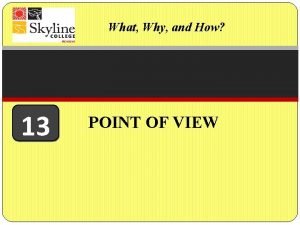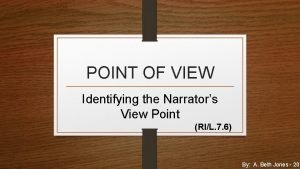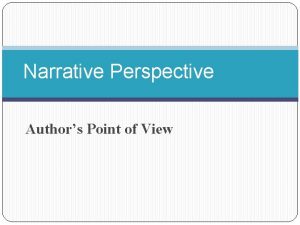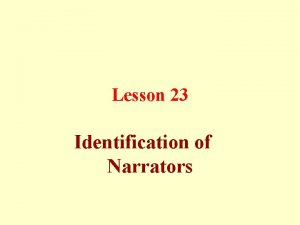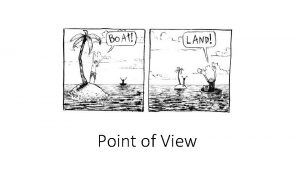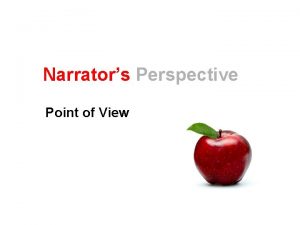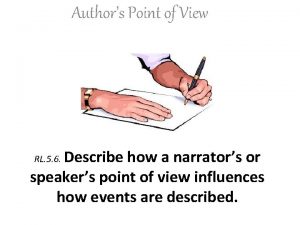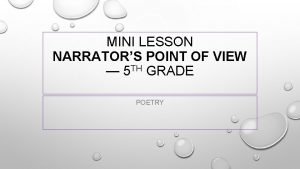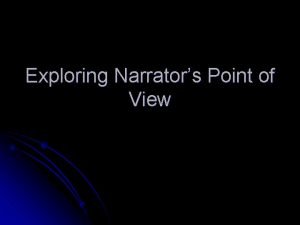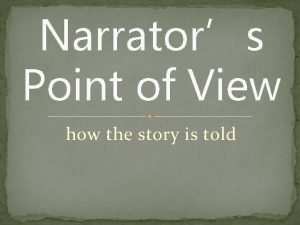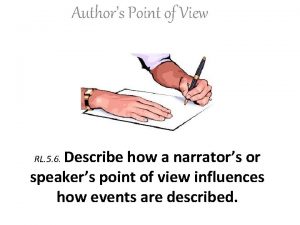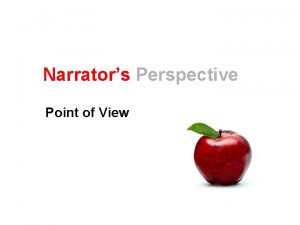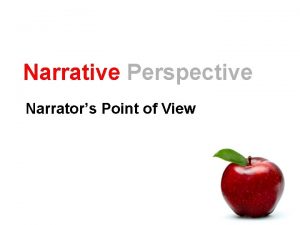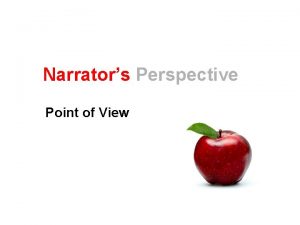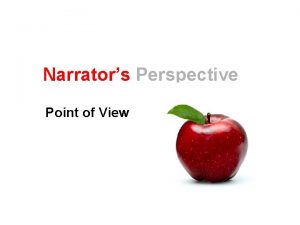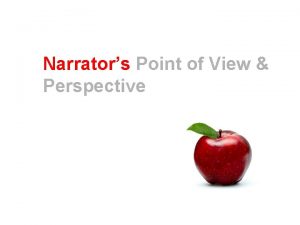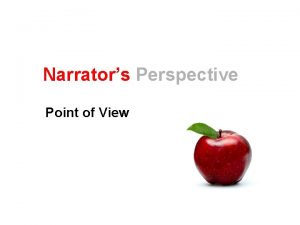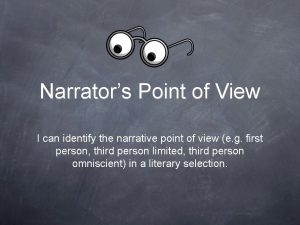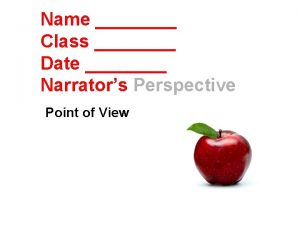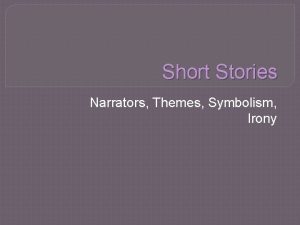POINT OF VIEW Identifying the Narrators View Point






















- Slides: 22

POINT OF VIEW Identifying the Narrator’s View Point (RI/L. 7. 6) By: A. Beth Jones - 201

CCSS. RI/L. 7. 6 – Point-of-View Explain how an author develops the point of view of the narrator or speaker in a text. • I can figure out an author’s point of view in a piece of informational text and explain how it is expressed in the text. • I can explain how an author develops the point of view of the narrator or speaker in a text.

POINT-OF-VIEW Identifying the narrator’s view point is an essential reading skill that is often assessed on standardized tests. The term “point of view” has many applications, from video game development to the interpretation of art. We will discuss point of view as it pertains to the study of reading and literature.

POINT-OF-VIEW When studying the perspective of the narrator, the reader is concerned with the relationship between the person telling the story (the narrator) and the agents referred to by the story teller (the characters).

MODES OF NARRATION There are six key terms used in the study of narrative view point: first-person, second-person, third -person limited, third-person omniscient, and third-person objective. Each term refers to a specific mode of narration defined by two things: the distance of the narrator from the story (the pronoun case) and how much the narrator reveals about the thoughts and feelings of the characters (narrative access).

FIRST-PERSON NARRATION In this mode, the narrator is usually the protagonist or central character in the story. But even if this character is not the protagonist, he or she is directly involved in the events of the story and is telling the tale “first hand. ”


First-person narration is easy to identify, because the narrator will be telling the story from “I’s” perspective. Readers should watch for the narrator’s use of first-person pronouns- “I, me, my, our, us, we, myself, and ourselves, ” as these will usually indicate that the passage is narrated from first-person perspective. *Remember, with this skill readers are trying to identify the perspective of the narrator; therefore, one must ignore the dialogue of characters (indicated by “quotation marks”) and solely focus on narration, otherwise one is not analyzing the narrator’s point of view.


SECOND-PERSON NARRATION In this mode of narration “you” are the agent, such as in this example: you walked down the stairs. As it is generally awkward for a story to be narrated from “your” perspective, this mode of narration is not used very often in narratives and stories. There are some exceptions, however, and second-person perspective is the primary mode of narration for Choose Your Own Adventure books and similarly styled writings.

WE NEED YOU!

More frequently, directions and instructions are usually narrated from second-person perspective. In most cases, directions will be written in short imperative sentences, where the implied subject is “you. ” But even when “you” is not explicitly stated, it is understood that “you” are the subject of directions and instructions.


THIRD-PERSON NARRATION With this mode of narration, the narrator tells the story of another person or group of people. The narrator may be far removed from or not involved in the story, or he or she may be a supporting character supplying narration for a hero. Frequent use of “he, she, them, they, him, her, his, her, and their” by the narrator may indicate that a passage is narrated from third-person perspective.

HE SHE THEY THEM

There are three distinct modes of third-person narration: limited, omniscient, and objective. Which mode the narrator is using is determined by a single variable- how much the narrator accesses the thoughts, feelings, and internal workings of the characters and shares them with the reader through narration. Characters’ feelings and motivations can be inferred and understood through their behavior and dialogue in each of the three modes of third-person narration; readers should be concerned with finding instances where the narrator explicitly reveals a character’s thoughts or


THIRD-PERSON LIMITED NARRATION When a narrator uses third-person limited perspective, the narrator’s perspective is limited to the internal workings of one character. In other words, the narrator reveals the thoughts and feelings of one character through explicit narration.

THIRD-PERSON OMNISCIENT NARRATION In this mode of narration, the narrator grants readers the most access to characters’ thoughts and feelings. With third-person omniscient narration, the narration will reveal more than one characters’ internal workings. OMNI = All SCIENT = Knowing Omniscient = All-Knowing


THIRD-PERSON OBJECTIVE NARRATION Jane’s video did not go into any detail about this point of view, so let us examine it here. In this mode of narration, the narrator tells a third-person’s story (he, she, him, her), but the narrator only describes characters’ behavior and dialogue. The narrator does not reveal any character’s thoughts or feelings.

References: Unknown Author of E-READING WORKSHEETS. “Point of View. ” E-Reading. Worksheets. NA. E-Reading. Worksheets. January 28, 2017. http: //www. ereadingworksheets. com/point-of-view/ Zebra Fox. “Writing with Jane: Point of View. ” You. Tube. com. November, 13, 2013. Zebra Fox. January 28, 2017. https: //youtu. be/-3 ks. Bb. NJu 4 Q Leslie Ann. “Point of View Posters. ” Teachers Pay Teachers. NA. Teachers Pay Teachers. January 28, 2017. https: //www. teacherspayteachers. com/Product/Point-of. View-Posters-1586548 Point-of-View Pilot – Online practice with POV: http: //ereadinggames. com/viewpoint-pilot/
 Point of view example
Point of view example Identifying and non identifying adjective clauses
Identifying and non identifying adjective clauses Whats an adjective clause
Whats an adjective clause Identify the essential
Identify the essential Narrators mom
Narrators mom Different types of narrators
Different types of narrators Examples of 2nd person point of view
Examples of 2nd person point of view Third person objective
Third person objective Hình ảnh bộ gõ cơ thể búng tay
Hình ảnh bộ gõ cơ thể búng tay Ng-html
Ng-html Bổ thể
Bổ thể Tỉ lệ cơ thể trẻ em
Tỉ lệ cơ thể trẻ em Chó sói
Chó sói Thang điểm glasgow
Thang điểm glasgow Alleluia hat len nguoi oi
Alleluia hat len nguoi oi Các môn thể thao bắt đầu bằng tiếng nhảy
Các môn thể thao bắt đầu bằng tiếng nhảy Thế nào là hệ số cao nhất
Thế nào là hệ số cao nhất Các châu lục và đại dương trên thế giới
Các châu lục và đại dương trên thế giới Công thức tiính động năng
Công thức tiính động năng Trời xanh đây là của chúng ta thể thơ
Trời xanh đây là của chúng ta thể thơ Cách giải mật thư tọa độ
Cách giải mật thư tọa độ Làm thế nào để 102-1=99
Làm thế nào để 102-1=99 độ dài liên kết
độ dài liên kết
